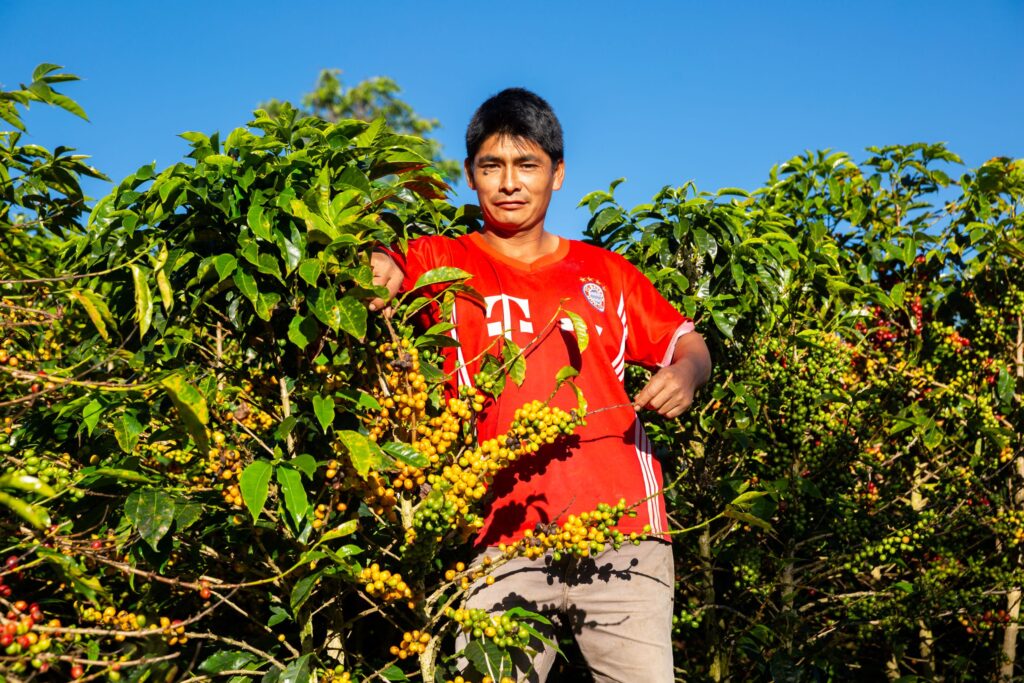The Harsh Reality
For many communities around the globe, there is a significant disparity between income and the cost of living. We’re seeing inflation and increasing consumer costs raise the cost of living for workers worldwide, widening the income gap and leaving basic needs like access to clean water, food, and housing unmet. This is known as “worker poverty”, and it impacts people in all industries and in all countries.
As costs continue to rise, more pressure is put on farmer and worker livelihoods. This pressure will continue to rise if action is not taken, forcing more people into working poverty despite being employed full-time. At Fair Trade USA, we believe that every worker has a right to bring home a living wage.
About Fair Trade USA’s Approach to Fair Wages
Fair Trade USA is committed to ensuring farmers get a fair price for their goods and workers receive a fair wage for their labor. And we are striving to go beyond that, towards a living income for all.
Fair Trade Certification helps to increase income in 5 ways:
1. We ensure that legal minimum wages are being paid by Fair Trade Certified producers. Fair Trade USA requires that all workers receive salaries and wages that are in line with, or exceed legally mandated minimum wages. This guarantee is a critical baseline component of our standards and is assured through rigorous auditing and certification processes. Improving incomes can only be reliably measured if we first ensure this baseline.
2. We ensure that farmers receive a minimum price for their goods to help protect from market changes on certain commodities. Since many commodities, like coffee, are traded based on market prices, the income farmers can expect for their crop can change daily. Imagine trying to budget for your family’s needs without knowing how much income you could expect. The fair trade minimum price is a safety net. It’s the lowest price that can be paid for a Fair Trade Certified product. The price is a ‘floor price’ that aims to cover producers’ cost of production. This mechanism contributes to increased income, specifically in times of market fluctuation. This leads to more reliable and viable incomes which is essential in support of achieving a living income. The minimum price also allows farmers to make additional investments in their farms as well as giving them access to credit as lenders are more willing to approve loans against a reliable income.

“For me, the most important part of being a cooperative member is that now I can provide a better life for my family. Before our sales were really bad and we had no control over the price. Sometimes we received only enough for the day, to buy food and nothing else, now we have a better economy and we are able to ask for loans.” – Andrés Bermeo Calderon, 33, La Prosperidad, Peru
3. We require equal pay for equal work, ensuring that marginalized groups are paid equally to their peers. Women, minorities, and other marginalized groups continue to be underpaid compared to their male counterparts. According to UN Women, women globally only make 77 cents for every dollar earned by men. Another disadvantaged group that is consistently paid less are migrant workers. Migrant workers make up large percentage of the people that pick, process, and manufacture many of the goods we consume, yet they are systemically underpaid compared to their peers. Fair trade standards prevent wage discrimination in all its forms. This includes discrimination based on gender or employment status of the worker, i.e., temporary, migrant, permanent, employed through a labor contract, etc. These requirements are backed up by our robust auditing and certification processes.
4. We ensure a Fair Trade Premium is paid for every Fair Trade Certified product. Through adherence to the Fair Trade USA Trade Standard, every company pays an additional sum of money above the purchase price of the Fair Trade Certified product, also known as the Fair Trade Premium. That money is then invested directly into a Community Development Fund that farmers and workers democratically determine how to spend, based on the outcomes of a needs assessment process. The projects established with these funds are used to improve their communities and lives. Increased incomes are one direct outcome of the Fair Trade Premium.

“We have been certified for 5 years now. Thanks to our certification, we have had the opportunity to build a new school for our families by using Community Development Funds received through our partnership with Fair Trade USA.” – Georges Kouakou Kouassi, producer at the COOP-CA-REFSI cocoa cooperative in the Koffikro section of Côte d’Ivoire.
In addition, many producers choose to use Fair Trade Community Development Funds to diversify their income. Income diversification was a focus of factory workers in India, who were able to get extra income through the implementation of a household appliances project that allotted each household a sewing machine.Households were then able to start small businesses on the back of this investment.
“I can sew blouses and things like that. I’ll sew blouses for myself and others after I’m off my work. Since my husband is no longer with us, I’d feel better doing that, because I can make more money through sewing jobs, too.” –Premium Participant from Prathiba in India
5. We are committed to helping employers understand the living wage gap and to support the transition to a living wage. Fair Trade Standards require that employers understand the living wage in their area, understand the gap between what they are paying and the local living wage, and take steps to reduce that gap. A living wage is defined as sufficient pay for a standard work week, in the local context, needed to provide a decent standard of living. This is a vital component in providing workers a path out of poverty. Elements of a “decent standard of living” include food, water, housing, education, health care, transportation, clothing, and other essential needs for the entire family.
Fair Trade USA has a 3-step approach to supporting employers and workers towards achieving a living wage:
- Accurately calculating a living wage–Fair Trade USA is a member of the Global Living Wage Coalition, which works to benchmarks what a living wage should be in a given location.
- Conduct a gap analysis between current wages and living wage–this is a requirement of all Fair Trade Certified producers. Fair Trade USA provides guidance and support on how to conduct that analysis. This builds out the framework used to calculate the local living wage and enables any gaps to be addressed.
- Develop a strategy to close the gap –once the living wage has been determined and the gap identified, producers are able to have transparent conversations to identify barriers to a living wage and develop strategies that share responsibility across the supply chain.
We are committed to improving incomes and livelihoods across supply chains through Fair Trade Certification. Our journey is far from over, however the vision of a living wage can only be successful when it is a collaborative effort across sectors and supply chains. By leveraging this strategy, we are taking concrete steps in the right direction to help put an end to working poverty and create a living income for all.